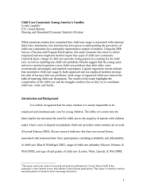
An official website of the United States government
Here’s how you know
Official websites use .gov
A .gov website belongs to an official government organization in the United States.
Secure .gov websites use HTTPS
A lock (
) or https:// means you’ve safely connected to the .gov website. Share sensitive information only on official, secure websites.
-
//
- Census.gov /
- Census Working Papers /
- Child Care Constraints Among America’s Families
Child Care Constraints Among America’s Families
Child Care Constraints Among America’s Families
While numerous studies have examined how child care usage is associated with maternal labor force attachment, less attention has been given to understanding the prevalence of child care constraints for a nationally representative sample of mothers. Using the 2004 Survey of Income and Program Participation, this study examines the extent to which employed and non-employed mothers report four types of child care constraints: restricted hours, change in child care provider, being placed on a waiting list for child care, as well as reporting any child care problems. Results suggest that the young, poor, and never-married experience more child care problems than their older, more economically advantaged, and married counterparts. Logistic regression results indicate that nonrelative child care usage by both employed and not employed mothers increase the odds of having child care problems, while usage of organized child care reduced the odds of reporting child care disruptions. The results of this study highlights the complexities of the child care and the struggles mothers face as they try to coordinate child care, work, and family.
Sources and Reference
Survey of Income and Program Participation, 2004 Panel, Wave 4.
Others in Series
Working Paper
Working Paper
Working Paper
Share
Some content on this site is available in several different electronic formats. Some of the files may require a plug-in or additional software to view.
 Yes
Yes
 No
NoComments or suggestions?


Top


